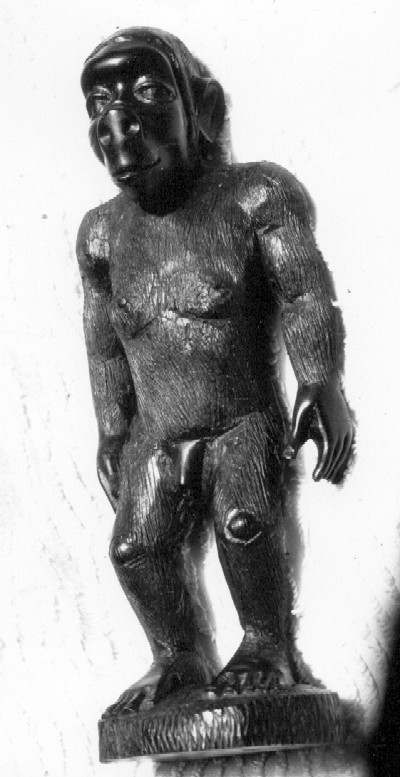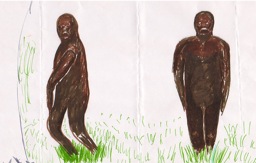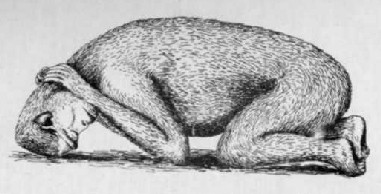Dzungarian Bare Knees
Posted by: Loren Coleman on December 8th, 2006
Why do some unknown hominoids have bare knees?

Wooden representation of a Proto-Pygmy from Africa.

Witness drawing of a Yowie from Australia.
In 1913, Muscovite V. A. Khakhlov submitted to the Russian Imperial Academy of Sciences his extraordinarily detailed report about the unknown hairy hominids of eastern Asia. In one section of the document, Khakhlov gathered reports from the native Kazakhs of Dzungaria.
Dzungaria is named after a Mongolian kingdom which existed in Central Asia during the seventeenth and eighteenth centuries. Today, Dzungaria is a geographical region within the Xinjiang Uygur Autonomous Region, northwestern China. The area is a largely steppe and semidesert basin surrounded by high mountains: the Tian Shan in the south and the Altai in the north. Outside of Asia, the name is mostly associated with Dzungarian hamsters (Phodopus campbelli or Phodopus sungorus, depending on your source).
Specifically, Khakhlov wrote an interesting passage which appears to explain, perhaps, what is found regarding the “bare knees.” Khakhlov noted the following, in his report (as recorded by Ivan T. Sanderson in Abominable Snowmen: Legend Come to Life), of one captive “wild woman” (an Almas) in the region of the River Manass, or Dam:
This creature seldom issued any sounds and usually was quiet and silent. Only when approached she bared her teeth and screeched. It [sic] has a peculiar way of lying down, or sleeping – like a camel, by squatting on the ground on its knees and elbows, resting the forehead on the ground, and resting the head [see drawing below from his report]. This position accounts for the unusually hard skin of the elbows and knees – like camel’s soles.
Could this be the reason for reports of bare knees? Could this aspect of certain representations of hairy hominoids be why this special trait is shown, due to shared behavior in using this sleeping position?

Sleeping position of an Almas from Asia.
About Loren Coleman
Loren Coleman is one of the world’s leading cryptozoologists, some say “the” leading living cryptozoologist. Certainly, he is acknowledged as the current living American researcher and writer who has most popularized cryptozoology in the late 20th and early 21st centuries.
Starting his fieldwork and investigations in 1960, after traveling and trekking extensively in pursuit of cryptozoological mysteries, Coleman began writing to share his experiences in 1969. An honorary member of Ivan T. Sanderson’s Society for the Investigation of the Unexplained in the 1970s, Coleman has been bestowed with similar honorary memberships of the North Idaho College Cryptozoology Club in 1983, and in subsequent years, that of the British Columbia Scientific Cryptozoology Club, CryptoSafari International, and other international organizations. He was also a Life Member and Benefactor of the International Society of Cryptozoology (now-defunct).
Loren Coleman’s daily blog, as a member of the Cryptomundo Team, served as an ongoing avenue of communication for the ever-growing body of cryptozoo news from 2005 through 2013. He returned as an infrequent contributor beginning Halloween week of 2015.
Coleman is the founder in 2003, and current director of the International Cryptozoology Museum in Portland, Maine.










I would think another possibility could be due to other reasons it may spend time on it’s knees as well. Drinking water, digging for insects, or digging up tubers fungus, or other underground food items. Maybe crawling in and out of dens or caves. Or maybe it’s a normal hair pattern for some species i.e. hair covered buttocks on some but not all apes.
I find it really hard to believe any hominid would be comfortable sleeping in this position. It looks more like a protective position to me, which could surely be the case if one was held captive. Baring ones teeth and screeching when being approached sounds like a frightened creature to me, I’d lie down in a fetal position too.
The position we see in the picture sure does not seem like a natural resting position for any creature of this type. I would tend to agree with the above that it is more of a defensive posture although this is speculation. Even humans tend to have rough knees or if your legs are hairy, the hair might be thinner on the knees. I would guess that the marked bareness of the knees (to the point where is is included in representations of the creature) may be due to everyday wear and tear from foraging, etc. I would like to know what other accounts there may be of this sleeping position. After all, maybe it was just a personal quirk of this particular specimen?
I believe that it is a mistake to refer to unknown primates as hominids, without more information. We are not even certain that they are primates. The evidence that they are primates is rather overwhelming so at least some of them probably are. Some or all of them may be hominids, but if we label them as such without better evidence, we prejudice ourselves to look at all the evidence from that viewpoint, which may be inaccurate.
Have to agree with you kittenz.
I prefer the use of “hominoids” and thus began this blog there, with a link to a blog that goes through the difference between “hominids” and “hominoids” the way I use them.
Of course, I used “hominids” with regard to Khakhlov’s report, out of respect for the Russian, because that was his characterization.
It seems clear to me, at least, we are dealing with hominoids.
One mistake in talking about any “unknown” animal is talking about what we “know” when we don’t know anything for sure, really. (Almost everything we “know” about dinosaurs, for example, is not knowledge but informed — more or less — speculation.)
I wouldn’t even go farther than “probable” in saying we have primates here (although the evidence seems to point clearly enough in that direction). Even though it may be awkward to always prefix everything about these animals with a “weasel word,” it’s wise at least to make the blanket statement, up front, that no one really knows until a specimen is in hand.
Are there any known primates that sleep in a position like the one above?
How do primates sleep? I know that orangutan make nests in the trees and gorillas make nests on the ground, but in what way do they sleep while in these nests? Also, do other primates like chimps, gorillas, and orangs have hairless knees? or hair missing from other places. And what is the hair pattern of apes? For example, Do they all have hairless faces, or do only a few have hairless faces. And what is the reason for not having hair in certain places?